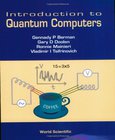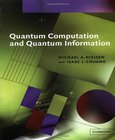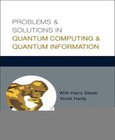Scalable Quantum Computers
Paving the Way to Realization

Book Details:
| Publisher: | Wiley-VCH |
| Series: | Wiley |
| Author: | Samuel L. Braunstein |
| Edition: | 1 |
| ISBN-10: | 3527403213 |
| ISBN-13: | 9783527403219 |
| Pages: | 376 |
| Published: | Apr 02 2001 |
| Posted: | Nov 19 2014 |
| Language: | English |
| Book format: | DJVU |
| Book size: | 4.44 MB |
Book Description:
Quantum computers hold the promise of solving problems that would otherwise be intractable with conventional computers. Some prototypes of the simplest elements needed to build a quantum computer have already been implemented in the laboratory. The efforts now concentrate on combining these elements into scalable systems. In addition, alternative routes to creating large scale quantum computers are continuously being developed.This volume gives a cross-section of recent achievements in both the theory and the practical realization of quantum computing devices. Samuel L. Braunstein (Reader, University of Wales, Bangor, and editor of the book "Quantum Computing - Where do we want to go tomorrow") and Hoi-Kwong Lo (Chief Scientist, MagiQ Technologies, Inc., NY) invited experts across many disciplines involved in the development of quantum computers to review their proposals in a manner accessible to the non-expert.Breaking with tradition, this book not only contains proposals, but a set of independent expert evaluations of these ideas as well. As a by-product this volume facilitates a comparison between the widely varying disciplines covered, including: ion traps, cavity quantum electrodynamics, nuclear magnetic resonance, optical lattices, quantum dots, silicon systems, superconductivity and electrons on helium.
Book categories:
Science & Mathematics , Networks, Protocols & APIs , Physics , Electromagnetism , Quantum Theory , Solid-State PhysicsDownload Link:
Related Books:
Introduction to Quantum Computers
Quantum computing promises to solve problems which are intractable on digital computers. Highly parallel quantum algorithms can decrease the computational time for some problems by many orders of magnitude. This book explains how quantum computers can do these amazing things. Several algorithms are illustrated: the discrete Fourier transform, Shor's algorithm for prime factorization; algorithms for quantum logic gates; physical implementations of quantum logic gates in ion traps and in spin chains; the simplest schemes for quantum error correction; correction of errors caused by imperfect resonant pulses; correction of errors caused by the nonresonant actions of a pulse; and numerical simulations of dynamical behaviour of the quantum Control-Not gate...
Quantum Computation and Quantum Information
In this first comprehensive introduction to the main ideas and techniques of quantum computation and information, Michael Nielsen and Isaac Chuang ask the question: What are the ultimate physical limits to computation and communication? They detail such remarkable effects as fast quantum algorithms, quantum teleportation, quantum cryptography and quantum error correction. A wealth of accompanying figures and exercises illustrate and develop the material in more depth. They describe what a quantum computer is, how it can be used to solve problems faster than familiar classical computers, and the real-world implementation of quantum computers. Their book concludes with an explanation of how quantum states can be used to perform remarkable feats of comm...
Problems & Solutions in Quantum Computing & Quantum Information
Quantum computing and quantum information are two of the fastest-growing and most exciting research areas in physics. The possibilities of using non-local behaviour of quantum mechanics to factorize integers in random polynomial time have added to this new interest. This invaluable book provides a collection of problems in quantum computing and quantum information together with detailed solutions. It consists of two parts: in the first part finite-dimensional systems are considered, while the second part deals with finite-dimensional systems. All the important concepts and topics are included, such as quantum gates and quantum circuits, entanglement, teleportation, Bell states, Bell inequality, Schmidt decomposition, quantum Fourier transform, magic ...
2007 - 2021 © eBooks-IT.org



